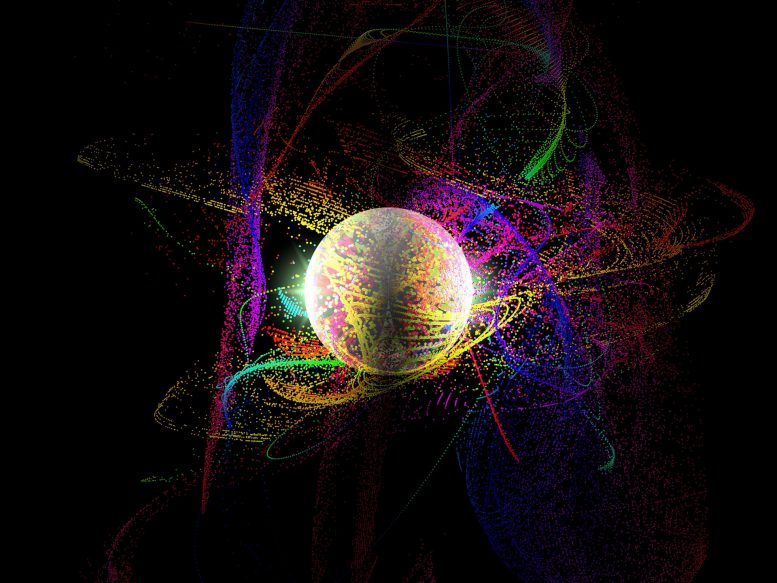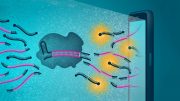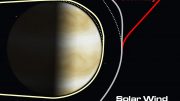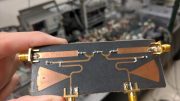
An artistic rendition of a ‘bound exciton’ quantum state used to prepare and read out the state of the qubits. Credit: 2013 Stef Simmons with CC BY
In a newly published study, an international team of researchers detail how they used an ensemble of phosphorous-31 donors in isotopically purified silicon-28 to demonstrate room temperature quantum bit storage lasting 39 minutes.
A normally fragile quantum state has been shown to survive at room temperature for a world record 39 minutes, overcoming a key barrier towards building ultrafast quantum computers.
An international team including Stephanie Simmons of Oxford University report in this week’s Science a test performed as part of a project led by Mike Thewalt of Simon Fraser University, Canada, and colleagues. In conventional computers, data is stored as a string of 1s and 0s. In the experiment, quantum bits of information, ‘qubits’, were put into a ‘superposition’ state in which they can be both 1s and 0 at the same time – enabling them to perform multiple calculations simultaneously.
In the experiment, the team raised the temperature of a system, in which information is encoded in the nuclei of phosphorus atoms in silicon, from -269°C to 25°C (-452°F to 77°F)and demonstrated that the superposition states survived at this balmy temperature for 39 minutes – outside of silicon the previous record for such a state’s survival at room temperature was around two seconds. The team even found that they could manipulate the qubits as the temperature of the system rose, and that they were robust enough for this information to survive being ‘refrozen’ (the optical technique used to read the qubits only works at very low temperatures).
‘Thirty-nine minutes may not seem very long but as it only takes one-hundred-thousandth of a second to flip the nuclear spin of a phosphorus ion – the type of operation used to run quantum calculations – in theory over two million operations could be applied in the time it takes for the superposition to naturally decay by 1%. Having such robust, as well as long-lived, qubits could prove very helpful for anyone trying to build a quantum computer,’ said Stephanie Simmons of Oxford University’s Department of Materials, an author of the paper.
‘This opens up the possibility of truly long-term coherent information storage at room temperature,’ said Mike Thewalt, who performed the test at Simon Fraser University in Burnaby, British Columbia, Canada, with colleagues.
The team began with a sliver of silicon doped with small amounts of other elements, including phosphorus. Quantum information was encoded in the nuclei of the phosphorus atoms: each nucleus has an intrinsic quantum property called ‘spin’, which acts like a tiny bar magnet when placed in a magnetic field. Spins can be manipulated to point up (0), down (1), or any angle in between, representing a superposition of the two other states.
The team prepared their sample at just 4°C above absolute zero (-269°C) and placed it in a magnetic field. Additional magnetic field pulses were used to tilt the direction of the nuclear spin and create the superposition states. When the sample was held at this cryogenic temperature, the nuclear spins of about 37% of the ions – a typical benchmark to measure quantum coherence – remained in their superposition state for three hours. The same fraction survived for 39 minutes when the temperature of the system was raised to 25°C.
‘These lifetimes are at least ten times longer than those measured in previous experiments,’ said Stephanie Simmons. ‘We’ve managed to identify a system that seems to have basically no noise. They’re high-performance qubits.’
There is still some work ahead before the team can carry out large-scale quantum computations. The nuclear spins of the 10 billion or so phosphorus ions used in this experiment were all placed in the same quantum state. To run calculations, however, physicists will need to place different qubits in different states. ‘To have them controllably talking to one another – that would address the last big remaining challenge,’ said Simmons.
A report of the research, entitled ‘Room-Temperature Quantum Bit Storage Exceeding 39 Minutes Using Ionized Donors in Silicon-28’, is published in this week’s Science.
Reference: “Room-Temperature Quantum Bit Storage Exceeding 39 Minutes Using Ionized Donors in Silicon-28” by Kamyar Saeedi, Stephanie Simmons, Jeff Z. Salvail, Phillip Dluhy, Helge Riemann, Nikolai V. Abrosimov, Peter Becker, Hans-Joachim Pohl, John J. L. Morton and Mike L. W. Thewalt, 15 November 2013, Science.
DOI: 10.1126/science.1239584








Be the first to comment on "Researchers Smash Room-Temperature Quantum Bit Storage Record"